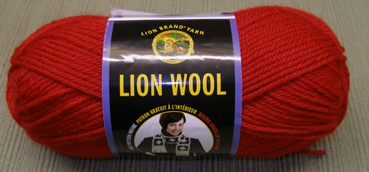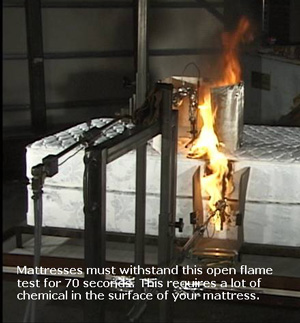40 years of manufacturing organic new technology mattresses for customers worldwide
Organics Burn
Many mattresses who claim to be "Organic" say they use wool as the flame barrier. While wool would pass the old cigarette test for mattresses, it will not pass the new open flame test. These mattresses either use chemically treaded wool, another chemical system, or rely on chemically treated cotton batting (Boric Acid and Antimony) to pass the open flame test.
There are no natural, chemical free, or nontoxic systems that pass the severe open flame test. Even what they call "inherently fire resistant" fibers contain chemicals in the fiber itself. There are no labeling requirements for the FR chemicals in mattresses. Thus, most mattress manufacturers deny using chemicals. It is unfortunate that even "Organic" mattress makers often claim to use no chemicals when a prescription mattress would be chemical free.
Wool Burn Test
 |
 |
 |
 |
 |
 |
| 2 Seconds | 6 Seconds | 10 Seconds | 14 Seconds | 18 Seconds | 20 Seconds - Gone |
Test performed with commercially available wool, you can repeat this test at home:
![]()

Lion Brand Wool
Relative summary of the
flammability properties of fibers:
| Fiber | Heat of Combustion (Kcal/g) |
Ignition Temperature (°C) |
| Cotton | 3.9 | 255 |
| Rayon | 3.9 | 420 |
| Nylon | 7.9 | 575 |
| Polyester | 5.7 | 560 |
| Wool | 4.9 | 600 |
| Zipro Wool (Treated with Zirconium, a heavy metal) | - | - |
Source: Commonwealth Scientific and Industrial Research Organization (CSIRO) (Australia) http://72.14.205.104/search?q=cache:Ugjs_oDjrlMJ:www.csiro.au/files/files/p9z9.pdf+Zirpro&hl=en&ct=clnk&cd=16&gl=us
A Propane torch like used in the mattress open flame test has a temperature of 1,980 (°C) or 3,596 (°F) http://en.wikipedia.org/wiki/Adiabatic_flame_temperature
 You can see in the table above that wool or any untreated
fiber including cotton, rayon, nylon, or polyester will not pass the open
flame test for mattresses. The flame temperature is more than three times that
required for ignition. Plus you can see proof in the burn photos above or
with your own test.
You can see in the table above that wool or any untreated
fiber including cotton, rayon, nylon, or polyester will not pass the open
flame test for mattresses. The flame temperature is more than three times that
required for ignition. Plus you can see proof in the burn photos above or
with your own test.
There are two ways, and only two ways, to make a fiber fire resistant: 1) Coat the fiber with FR chemicals, 2) Manufacture the fiber with FR chemicals incorporated into the fiber itself. These are called "inherently fire restraint" fibers.
The US Consumer Products Safety Commission (CPSC) did not want the public to know the FR chemicals contained in mattresses (they are all scary), so there are no labeling requirements.
Mattress manufacturers do not want to admit using chemicals so they say "we use a natural system" or "we use wool" or "we use 'inherently fire resistant' fibers." Again, 'inherently fire resistant" fibers contain chemicals, such as Antimony in the fiber itself in Modacrylic fibers.
Another popular inherent system they try to call 'Rayon' contains Silica Glass (a respiratory hazard) and other chemicals such as Phosphates or Antimony. (See CPSC Table of Chemicals in Mattresses)
Some fireproofing systems spray or apply chemicals. The CPSC says there are some chemical free systems, meaning the inherent systems. This double talk is very misleading because even the inherent systems have toxic and cancer causing chemicals in the fiber itself. The CPSC proved Antimony leaches out of these fibers and says we will absorb .8 mg Antimony every night from mattresses, this is 27 times more than the EPA says is safe. (See Mattresses Toxic by 27X)
From a Patent on making wool and natural fibers flameproof:
"The present invention concerns methods of inhibiting the burning of natural fibers (e.g., wool, wool fibers, animal hair, cotton), synthetic fibers (e.g., acetate, nylon, polyester, viscose rayon), or blends thereof (e.g., wool/cotton blends), or fabrics or yarns composed of natural fibers, synthetic fibers, or blends thereof, involving treating the fibers (or fabrics or yarns) with polyamic acid or at least one polyimidesiloxane or mixtures of polyamic acid and at least one polyimidesiloxane."
"Conventional chemical
treatments to confer flame resistance to wool include treatment with the
flame retarding agents applied to cotton, such as salts of borate,
phosphate, metals, and tetrakishydroxymethyl phosphonium, and titanium
compounds. Zirconium complexes under the trademark Zirpro™, issued by
the International Wool Secretariat, are one of the successful flame
retardants for wool. Many modifications of the Zirpro™ process according to
specific needs have been made. For example, tetrabromophthalic acid (TBPA)
is used along with Zirpro™ to obtain low heat release wool. However,
zirconium salts have the environmental disadvantage of zirconium being a
heavy metal."
http://www.freepatentsonline.com/7264637.html
Lanolin burns, as would any animal oil.
Here are some quotes from the Material Safety Data Sheet on Lanolin, from http://www.jtbaker.com/msds/englishhtml/l1268.htm
"Fire Fighting Measures
Fire: Flash point: 238C (460F),
Autoignition temperature: 445C (833F)
Explosion: Above the flash point, explosive vapor-air mixtures may be
formed.
Fire Extinguishing Media: Dry chemical, foam or carbon dioxide."
You can see above Lanolin burns at an even lower temperature than wool, 445C vs. 600C, (it is not a natural flame retardant), and it requires dry chemical, foam, or carbon dioxide to extinguish the fire.
From "Commonwealth Scientific and Industrial
Research Organization (CSIRO):"
"The evolution of increasingly severe
mandatory flammability regulations in many aspects of domestic, social and
business life has meant that even inherently low flammability fibres, such
as wool, require a flame retardant treatment for some applications. Typical
applications subject to mandatory flammability requirements include
children's nightwear, domestic and commercial furnishings, public
transportation and protective clothing. … "
"The flame resistance of all textiles, including wool products, can be improved by selected chemical treatments. Initially, fire retardant treatments for wool were based on the impregnation of borates, phosphates and to a limited degree the organic phosphorus compounds more commonly associated with cellulosic fibres. The introduction of stricter flammability requirements for airline furnishings resulted from a review of general aviation standards coinciding with the release of wide bodied aircraft in the early 1970's. Many flammability treatments available at the time did not satisfy the new requirements, so The International Wool Secretariat developed a new flame retardant treatment based on the reaction of zirconium or titanium salts with wool. A suite of treatments, based on these two actives, was eventually developed under the generic title of “Zirpro”, to cover a variety of flammability standards and care claims." http://72.14.205.104/search?q=cache:Ugjs_oDjrlMJ:www.csiro.au/files/files/p9z9.pdf+Zirpro&hl=en&ct=clnk&cd=16&gl=us
One organic mattress maker was quoted in the Chicago Tribune article as saying he spent over $100,000 in burn testing to find the right combination of cotton and wool to pass the open flame test.
They could have spent 100 million dollars and would not be able to find a combination of untreated cotton and wool to pass the test.
Untreated cotton will even ignite from cigarettes. Since the 1973 cigarette ignition law for mattresses they have been adding 10% Boric Acid (Roach Killer) powder as loose dust to cotton batting to pass the cigarette test. Since the open flame test they now also add Modacrylic fibers, which contain Antimony Trioxide, to cotton batting to pass the open flame test. See CPSC Table 1, item 1.
Cotton burns at 255 degrees and untreated Wool burns at 600 degrees. The open flame test is 2,000 degrees for over a minute. It is scientifically impossible for a blend of untreated cotton and wool to pass the test.
No one wants to admit using chemicals in their mattresses, especially ones who claim to be organic.
Organic Certifications: We question the value of organic certifications. Companies pay money to these organizations to get certified and provide the information they want them to see. But these organizations do not know about the chemicals added to pass the new flameproof mattress regulation.
When you look at: http://www.organicmattressreviews.com/manufacturer.html
Near the bottom of the page you will see these quotes about some mattresses that claim to be organic
“However, if you order their free sample, you can look and see that they are not using all organic materials. Bordering the wool (on the inside of the mattress), is not an organic cotton, but some other type of material. Additionally, they use a non-organic and non-natural material in the side borders of the mattress to meet the flame retardant requirements.”
Next down the list is a another quote:
“They do use a sand based material mixed in with their wool to help meet the flame retardant standards.”
Sand is Silicon (Si) which you can see on the CPSC table of chemicals used in beds When you melt sand it makes glass. This is the Silica Glass or simple glass that is in the fibers of “inherently fire resistant fibers” that they call viscose, Visil, or FR Rayon. It is an extreme respiratory hazard and known to cause illness and cancer. (See CPSC Table of Chemicals in Mattresses)
Below are quotes from a wool fire barrier suppler to the mattress industry who double talks the issue but admits adding chemicals to the wool to pass the open flame test (A sand based material):
"....utilizes a blend of natural wool
and inherently FR viscose fibers. ... potentially eliminating the
necessity for secondary “sock” barriers in latex core mattresses. [Yes,
Latex burns like crazy and it requires a lot of chemicals in the fire
barrier to get it to pass the new open flame test.]
http://www.sleepsafetech.com/news.htm
and "the special blend of
natural wool and inherent viscose fibers ..."
http://www.sleepsafetech.com/products.htm
Again, 'inherently fire resistant" fibers contain chemicals, such as Glass, PVDC, Antimony, or Formaldehyde in the fiber itself. (See CPSC Table of Chemicals in Mattresses)
Unfortunately almost all the organic mattresses strongly tell people they use no chemicals and that their untreated wool passes the test. They also sometimes say the fire proof wool is compressed or densified and this blocks the oxygen and fire. We don’t believe this either. The above wool system where they admit adding chemicals is also densifed or compressed.
The logical questions is that if some organic mattresses have to add chemicals to pass the open flame test, don't they all have to? The answer is Yes!
As you can see in all the proof above everything organic burns, there are no natural, chemical free, or nontoxic mattresses that comply with the federal regulation. They all contain toxic chemicals. Your only choice for a chemical free mattress is by prescription.